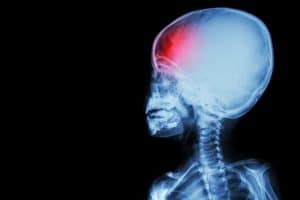How to Determine if Your Child Suffered a Brain Injury
 Whenever a child suffers damage to the skull, brain, scalp or any other tissue or blood vessels in the head, you need to be wary of brain injuries. A traumatic brain injury (TBI) is determined on the severity of the child’s injury. Head injuries can be as minor as a bump or bruise to the head or as severe as a concussion, internal bleeding, broken skull bones, or damage to the brain.
Whenever a child suffers damage to the skull, brain, scalp or any other tissue or blood vessels in the head, you need to be wary of brain injuries. A traumatic brain injury (TBI) is determined on the severity of the child’s injury. Head injuries can be as minor as a bump or bruise to the head or as severe as a concussion, internal bleeding, broken skull bones, or damage to the brain.
The CDC reports that head injuries are the number one leading cause of disability and death in children and young adults in the United States.
What is a concussion?
An injury to the head that prevents the brain from normally functioning for a short period is classified as a concussion. Generally speaking, a child’s alertness and awareness are affected with this kind of TBI and can last from a few hours to a few weeks, depending on the severity of the injury. There are different levels of severity when it comes to concussions, from mild and brief to severe and long-lasting. Sometimes it can be difficult to know if a child is suffering from a concussion.
What is a contusion of the head?
Contusions occur when your child suffers a brain bruise. Children who experience a contusion will have swelling and bleeding inside the brain. It is not abnormal for a contusion to appear on the opposite side of the head from the actual area of injury. This is the result of the brain rocking into and hitting the other side of the skull.
Violent blows to the head, whiplash, and violent shaking are all ways in which your child can suffer a contusion. When the brain hits the inside of the skull, the internal blood vessels, tissues, and lining can tear.
What are skull fractures?
A skull fracture occurs when the skull bone suffers a break. There are four types of skull fractures: basilar, diastatic, depressed, and linear.
- A basilar skull fracture is when a bone from the base of the skull breaks. This leads to a serious injury. Bruises behind the ears and around the eyes may appear. There might be fluid pouring from the ears or nose. This type of serious injury will mandate close monitoring at the hospital.
- Diastatic skull fractures occur on the lines of the skull. This part is jagged and located between the skull bones. When a child experiences a diastatic skull fracture, normal suture lines become widened. Newborns and infants are the main groups to suffer from this type of injury.
- During a depressed skull fracture, a portion of the skull sinks in due to a broken bone. There may or may not be a cut to the scalp, but surgery is essential if the part of the indented skull touches the brain.
- When a child experiences a linear skull fracture, part of the bone breaks but does not move. Hospital monitoring is one of the proper ways to treat this type of head injury. On a general timeline, a child can return to normal activities within a couple days. No other treatment is usually needed for this fracture.
What are the typical causes of head injuries in children?
The main culprits of head injuries include sports injuries, falls, motor vehicle accidents, being struck by a vehicle, and child abuse. Teenagers present as the group with the highest risk, and it is more common to see males opposed to females with head injuries. Sometimes you can notice a rise in head injuries with the rise in weather temperatures as well. Children are known to be outside more often during the warmer weather seasons, which is why most head injuries happen in the spring and summer. Sports like football, soccer, and basketball also put children at a higher risk of sustaining head injuries.
What are symptoms of head injuries and TBIs?
Some symptoms of mild head injuries include the following:
- Raised swollen area from a bump or bruise
- Small shallow cut in the scalp
- Headache
- Sensitivity to noise and light
- Irritability or abnormal behavior
- Confusion
- Problems with balance
- Nausea
- Blurred or double vision
Symptoms of moderate head injuries in children can include:
- Fatigue
- Trouble staying awake
- Loss of consciousness
- Severe headache that will not ease up
- Loss of short-term memory
- Slurred speech
- Repeated nausea and vomiting
- Trouble walking
- Pale skin color
- Deep cut in the scalp
Symptoms may occur differently depending on the child, but always ensure you seek medical attention.
How is a child’s head injury diagnosed?
Healthcare providers are trained to ask about your child’s symptoms, health history and recent injuries. A physical examination and additional tests, like X-rays, blood tests, MRIs and CT scans are never out of the question. “ImPACT” tests are given to children involved with organized sports. During this type of test, a child’s brain processing is measured in depth. Children should have this test at both the beginning and end of the sports season if they have been subjected to a head injury.
How do you treat a head or brain injury?
The type of treatment your child will receive depends greatly on their symptoms, age, general health, and severity of the injury. Typical treatment procedures involve rest, ice, antibiotic ointment and bandages, stitches (for open wounds), and being observed for a period in case problems arise. Medicine to help sleep or relax, breathing machines for ease, diagnostic tests, and surgery can be used to help alleviate more serious injuries.
Did your child suffer a brain injury in an accident or as a result of an assault? No matter the situation, you might have legal recourse against the parties responsible. Call the experienced Charlotte, N.C. brain injury attorneys at Warren & Kallianos, PLLC today at 704-377-7777, or complete our contact form to schedule an appointment.

At Warren & Kallianos, we believe in the importance of working directly with our attorneys, Jeff Warren and Chris Kallianos. When you work with our firm, Jeff and Chris are always accessible to you throughout the progress of your case.
Read more about Warren & Kallianos, PLLC
